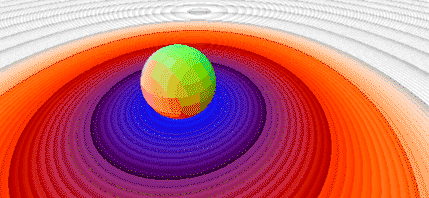glsl-ruler
v1.0.1
Published
GLSL SDF function for generating a sphere.
Downloads
19
Maintainers
Keywords
Readme
glsl-ruler
Helper module for debugging raytraced SDFs inspired by Johann Korndorfer's "How to Create Content with Signed Distance Functions" talk at NVScene 2015.
Thanks to Ryan Alexander for his example implementation on Shadertoy :sparkles:
Usage
trace = require(glsl-ruler/trace, <map>, <steps>)
Currently, glsl-ruler needs to handle raytracing on your behalf – it does so using an API very similar to glsl-raytrace. For further details, check out that project's documentation.
vec3 trace(vec3 ro, vec3 rd)
The key difference here between glsl-ruler/trace and glsl-raytrace is that instead of returning a vec2, trace will return a vec3 with the elements corresponding to:
- The signed distance value retrieved from a raytrace of your
mapfunction merged with the ruler plane. - A second attribute for assigning an ID to surfaces. This will be
-1.0if the ray hit the plane. - The signed distance value retrieved from a raytrace of only
your
mapfunction. You can then use this to color the plane.
color = require(glsl-color)
vec3 color(float distance)
Returns an RGB color for the plane based on the distance value of your signed distance field.
Example
By combining the above two modules together, you can quickly tweak existing glslify-driven raytracers to debug and explore 3D SDFs:
vec2 doModel(vec3 p);
#pragma glslify: camera = require('glsl-turntable-camera')
#pragma glslify: trace = require('glsl-ruler/trace', map = doModel, steps = 90)
#pragma glslify: color = require('glsl-ruler/color')
// creates a unit sphere at the origin
vec2 doModel(vec3 p) {
return vec2(length(p) - 1.0, 1.0);
}
void main() {
vec3 color = vec3(0);
vec3 rayOrigin, rayDirection;
camera(iGlobalTime * 0.175, 2.5, 3.0, iResolution, rayOrigin, rayDirection);
// This works just the same as glsl-raytrace would,
// however returning a vec3 instead of a vec2.
vec3 t = raytrace(rayOrigin, rayDirection);
if (t.x > -0.5) {
vec3 pos = rayOrigin + t.x * rayDirection;
vec3 nor = getNormal(pos);
color = nor * 0.5 + 0.5;
// if t.y is below 0.5, then you need to draw
// the ruler plane instead. Simply feed it t.z,
// the SDF from your map function, to get a color
// in return.
color = t.y < -0.5 ? gradient(t.z) : color;
}
gl_FragColor = vec4(color, 1.0);
}For a full example, see demo.frag.
Contributing
See stackgl/contributing for details.
License
MIT. See LICENSE.md for details.


